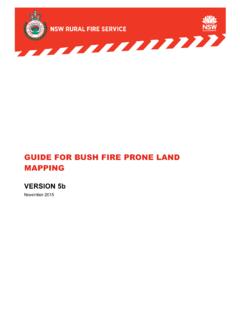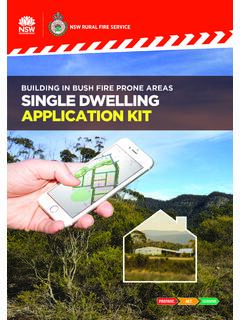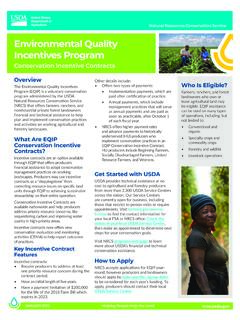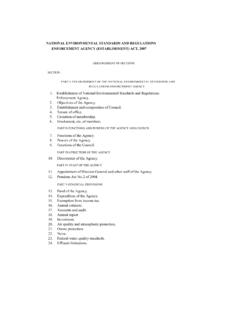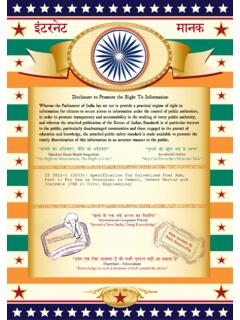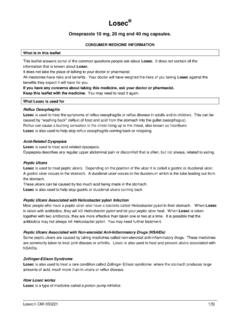Transcription of Bushfire Attack Level (BAL) & Complying Development ...
1 Bushfire Attack Level (BAL) & Complying Development Certificate (CDC) Checklist COMMUNITY RESILIENCE PRACTICE NOTES Version 1 August 2012 This Practice Note provides a checklist of minimum requirements the NSW Rural Fire Service (RFS) recommends for a BAL Certificate and CDC under the State Environmental Planning Policy (Exempt and Complying Development Codes) 2008 (Codes SEPP). Under clauses and of the Codes SEPP Development on some bush fire prone land may be considered as Complying Development .
2 A BAL Certificate must be obtained from the council or a person who is recognised by the RFS as a suitably qualified consultant in bush fire risk assessment prior to lodging an application for a CDC. Complying Development cannot occur on land identified as high bush fire risk (BAL 40 or FZ) by the council or a suitably qualified consultant. For Complying Development to occur on lots considered to be low bush fire risk, the land must be certified as being below a BAL 29 risk rating and meet specific Development standards for construction on such land.
3 The BAL certificate should also certify the land and any associated access in not BAL 40 or BAL FZ. Requirements for BAL Certificates In order for a BAL Certificate to be recognised, the certifying authority (council or accredited certifier) must be satisfied that a number of minimum requirements are met. The BAL assessment comes from Section 2 of Australian Standard 3959 Construction of buildings in Bushfire -prone areas 2009. It takes into consideration a number of factors including the Fire Danger Index, slope of land, surrounding vegetation types and proximity of vegetation to the building (existing or proposed).
4 Consultants, councils and accredited certifiers must ensure the BAL certificate is accurate and truthful in every respect. An accredited certifier should also ensure the BAL assessment is consistent with neighbouring lots (where applicable). A chart has been provided on the following page to describe the six BALs that are identified in AS3959 and how these relate to Complying Development . The Codes SEPP specifies that a BAL Certificate need only identify that a site is not BAL 40 or BAL FZ.
5 However the RFS has identified the need to include other relevant information to be incorporated on a BAL Certificate to assist the council, accredited certifiers and developers. Further details on suitably qualified consultants can be found in Fast Fact 5/10 Suitably Qualified Consultants and Practice Note 1/10 Requirements for Suitably Qualified Consultants available at 1 of 3 3/12 3/12 COMMUNITY RESILIENCE PRACTICE NOTES Requirements for a CDC A CDC Criteria Checklist has been prepared by the RFS to be considered by the certifying authority when determining a CDC on bush fire prone land and is provided on the following page.
6 As detailed in section 130A of the Environmental Planning and Assessment Regulation 2000 for a CDC on bush fire prone land, the certifying authority must send a copy of the Complying Development certificate and any associated documentation (including the BAL Certificate) to the RFS for operational and audit purposes. BAL LEVELS DESCRIPTION Complying BAL LOW There is insufficient risk to warrant specific construction requirements. YES BAL Ember Attack . BAL 19 Increasing levels of ember Attack and burning debris ignited by windborne embers together with increasing heat flux between and 19 kW m2.
7 BAL 29 Increasing levels of ember Attack and burning debris ignited by windborne embers together with increasing heat flux between 19 and 29 kW m2. BAL 40 Increasing levels of ember Attack and burning debris ignited by windborne embers together with increasing heat flux with the increased likelihood of exposure to flames. NO BAL FZ Direct exposure to flames from fire front in addition to heat flux and ember Attack . Addressing issues up front For developers it is best practice to identify specific bush fire issues relating to the property before designing a project to minimise costs of amending architectural and construction plans later on in the process.
8 RFS Audits The RFS has an agreement with the Department of Planning and Infrastructure to audit CDCs on bush fire prone land and does this on a regular basis. 2 of 3 Bush Fire Attack Level (BAL) Table CDC - BAL CERTIFICATE CHECKLIST Complies YES NO Expiry date for BAL is identified on Certificate and within date range (12mth expiry preferred). Bush Fire Attack Level (BAL) is identified on Certificate BAL is BAL 29 or less (not BAL 40 or BAL FZ) in accordance with the Codes SEPP BAL Certificate issued by a recognised suitably qualified bush fire consultant/business (refer to Practice Note 1/10).
9 CDC - Criteria Checklist Complies YES NO Is the land mapped as bush fire prone? The part of the lot on which Development is proposed is NOT in bush fire Attack Level BAL 40 or BAL FZ (BAL Certificate must be attached to application). The Development conforms to the specifications and requirements of the following that are relevant to the Development : I. Planning for Bush Fire Protection (ISBN 0 9751033 2 6) published by the NSW Rural Fire Service in December 2006, or subsequent versions, II. Addendum: Appendix 3 (ISBN 0 9751033 2 6, published by the NSW Rural Fire Service in 2010) Planning for Bush Fire Protection (ISBN 0 9751033 2 6), III.
10 Any other document prescribed by the regulations for the purpose of section 79BA of the Environmental Planning and Assessment Act 1979 The requirements of AS3959:2009 Construction of buildings in Bushfire prone areas set out in the Building Code of Australia have been met. All required Bushfire construction requirements are detailed on the plans forming part of the CDC application Reticulated or bottled gas on the lot is installed and maintained in accordance with AS/NZS 1596:2008-The storage and handling of LP Gas and the requirements of relevant authorities (metal piping must be used) Any gas cylinders on the lot that are within 10 metres of a dwelling house: I.





